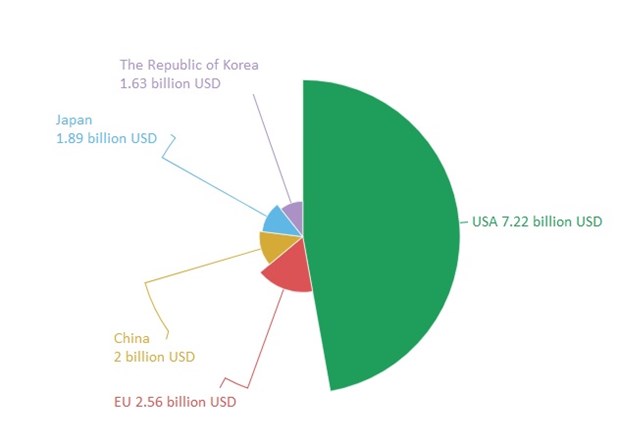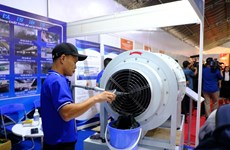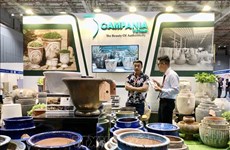EVFTA imposes ‘more comfortable’ rules on Vietnamese textile
 As EVFTA requires rules of origin to apply from fabric onwards, Vietnamese textile firms are allowed to use fabric from the Republic of Korea (Photo: Vietnam+)
As EVFTA requires rules of origin to apply from fabric onwards, Vietnamese textile firms are allowed to use fabric from the Republic of Korea (Photo: Vietnam+)Hanoi (VNA) - According to insiders, the EU-Vietnam Free Trade Agreement (EVFTA) will open up huge opportunities for various industries, including garment and textile.
In order to discuss more about the aforementioned opinion, Executive Director of Vietnam Textile and Garment Group (Vinatex) Cao Huu Hieu granted an interview to Vietnamplus, in which opportunities and challenges facing Vietnam’s textile and garment industry once EVFTA comes into effect are explained thoroughly.
Revenue of textile and garment export to EU expected to soar
- What do you think about the export of garment and textile in the first half of 2019? Could you please highlight the industry’s remarkable achievements, especially in EU market?
Cao Huu Hieu: According to official statistics, export revenue of garment and textile in the first six months is estimated at 18.1 billion USD, up 9.3% year-on-year; in which, garment and textile export to EU reaches 2.56 billion USD, marking an increase of 4.52% compared to the same period last year.
The escalation of US-China trade war has posed radical challenges to both global and domestic chains of garment and textile.
Not to mention, the volatile global material market also has exerted massive impacts upon domestic garment and textile industry, who ships 70% of its exports to China. However, the situation is still under control.
In my opinion, garment and textile still could enjoy strong export growth, which is expected at nearly 39.8 billion USD, 9.5% higher than that of 2018.
- Garment and textile export in H1 2019:

- With the aforementioned situation, what can Vietnamese garment and textile enterprises expect from the EVFTA?
Cao Huu Hieu: After EU and Vietnam signed the deal on June 30, EVFTA needs to be submitted to the European Parliament for approval. Following the approval, the trade deal is expected to come into force in 2020 after the European Council’s final examination.
EU is a promising market for Vietnam’s garment and textile sector as EU is the biggest importer of garment and textile products globally with the bloc’s importing power in 2018 reaching 280 billion USD, accounting for 35% of global import value.
Meanwhile, Vietnam has only contributed 2% to the EU’s garment and textile importing picture. The number has proved the domestic sector’s exporting potentials to the EU is yet to be fully tapped.
The situation is attributed to the differences in consuming habit of EU member countries. Not to mention, they often place rather small orders. Meanwhile, Vietnamese enterprises appear to hesitate over small orders.
With the tariff cut, garment and textile export to the EU is expected to thrive.
 Executive Director of Vietnam Textile and Garment Group (Vinatex) Cao Huu Hieu grants an interview to Vietnamplus (Photo: Vietnam+)
Executive Director of Vietnam Textile and Garment Group (Vinatex) Cao Huu Hieu grants an interview to Vietnamplus (Photo: Vietnam+)- One of prerequisite conditions for Vietnamese enterprises to be eligible for benefits from EVFTA is rules of origin. Up to this point, what have the sector in general and Vinatex in particular prepared? What are your challenges and how would you address them?
Cao Huu Hieu: EVFTA rules of origin seem more liberal than those regulated in the Comprehensive and Progressive Trans-Pacific Partnership (CPTPP). Specifically, as EVFTA requires rules of origin to apply from fabric onwards, Vietnamese textile firms are allowed to use fabric from the Republic of Korea. Currently, 14% of Vietnam’s fabric imports are from the Republic of Korea.
Therefore, Vinatex has implemented various prepping measures, including market development and training other enterprises within the sector on FTAs in general and EVFTA in particular.
We strongly recommend member firms within our group to establish effective chains in order to lower the selling price while improving products’ quality towards meeting rules of origin.
We have also targeted FOB and ODM approaches in exporting.
Technology transfer, building human resource capacity
- Under win-win principle, how can we balance between attracting European investors in garment and textile industry and bolstering exports to the EU market?
Cao Huu Hieu: Traditional investors in garment and textile industry come mainly from the RoK, mainland China, Taiwan (China) and Hong Kong (China) as they are geographically close to us with quite similar norms and practices.
For European firms, we expect technology transfer and machinery import more. Especially given the fourth industrial revolution, more European enterprises are expected to cooperate with Vietnamese firms in fabric dyeing technology.
Human resource to operate new technology and equipment is also crucial for the sector’s development. So we hope that the two sides can also hold more training courses to building capacity of Vietnamese core personnel in garment and textile industry.
- Thank you so much./.













